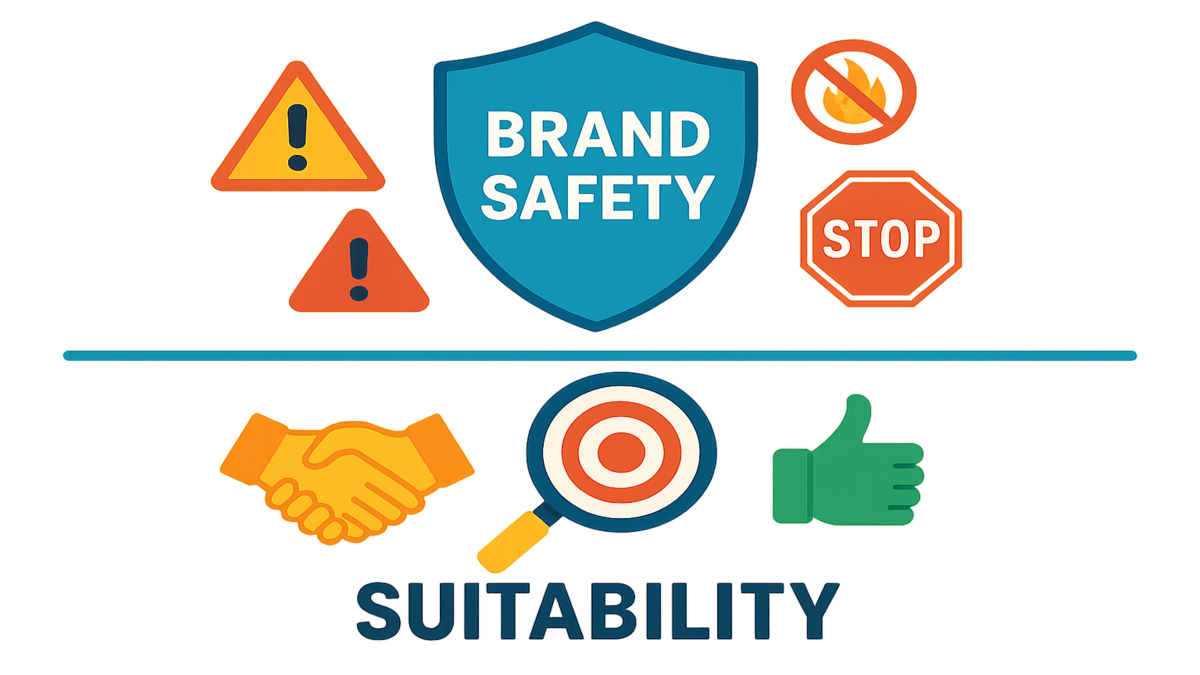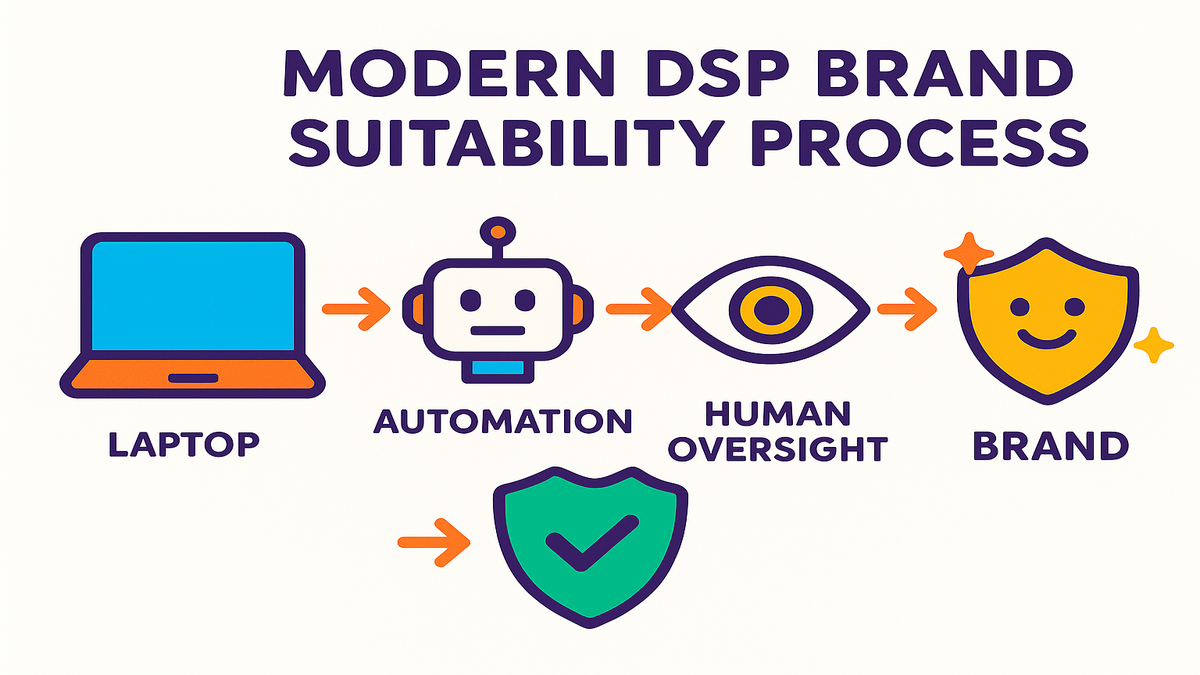
How To Master DSP Brand Safety And Suitability Controls

Nobody wants their cat food ad popping up next to a "How to Turn Your Pet Into a Rug" video. Welcome to programmatic advertising, where one mistake can wreck your brand quicker than you can say “brand safety.”
Let’s be honest—online ads change daily. Every brand wants eyes on their stuff, but nobody wants their logo near scandal, bad jokes, or anything plain weird. Feels dramatic, but it’s true. One wrong placement and Twitter blows up, people lose trust, and suddenly your budget’s getting cut.
But here’s the good news: you don’t gotta play ad roulette anymore. With the newest Demand Side Platform (DSP) brand controls, you get more than just a seat—you basically get the chef’s hat. Amazon Ads and Adobe DSP now have open beta features, so you can set guardrails, peek at live data, and block placements before things get embarrassing.
This isn’t just about blocking those websites that scream “NOPE.” Brand suitability is next-level. It’s about making sure your ads land where they help, not hurt. Want to fine-tune your Twitch ads or click through and teach your DSP what’s “funny edgy” and what’s “just… no”? Now you can.
You want a win? You need to balance reach, safety, and your brand vibe—without killing the whole campaign. Here’s how to do just that.
In digital ads, trust is gold. Lose it? You’ll pay for it.
Key Takeaways:
- Nail ad placement with new DSP suitability tools
- Use real-time controls and third-party platforms for safety
- Play with inventory filters to find your risk/reward sweet spot
- Tailor your goals for better optimization without losing your brand voice
- Stay ready: open beta features change fast, so keep tweaking

Brand Suitability
Brand Safety vs. Suitability
Brand safety is like having airbags. It blocks the worst stuff—hate, violence, NSFW things. But brand suitability? That’s GPS. It helps you even pick the safe streets. If you’re selling fancy cars, you probably don’t want your ad rolling before a cat-fail video. Doesn’t fit.
Brand suitability is big-picture thinking. Every ad matters. One slip and the damage spreads fast. It’s about style, mood, and matching your audience. Banks don’t want to show up by stories about fraud. If you sell cereal to kids, you don’t want your ad near violent cartoons.
Context in Impressions
Context is everything. Imagine your vegan snack shows up on a BBQ channel. Kinda awkward. With new controls, you can block certain genres, set the vibe you want, and even tell it to allow smart jokes but never mean ones. Your brand feels like it’s there on purpose, not by mistake.
Twitch and Amazon DSP
Amazon DSP’s beta gives you more power. You can skip whole genres, like shooter games, if you sell family snacks. Use it like a super-remote: block, skip, or approve channels that signal your mission, but still hit Twitch’s big audience. In the words of Natalie Moine, a digital ad pro:
"Advertisers want their message to land safe and strong. Suitability controls aren’t overkill. They’re basic."
Want this kind of control on your campaign? Check out DSP Services for Amazon DSP help and brand safety tools.
DSP Suitability Controls
API Level Controls
Now, open betas in Amazon DSP make it so rules aren’t trapped in dashboards. You set placement rules by account, brand, or ad group—however deep you need:
brandSafetyTierInheritedSettingDetails: Set big rules for an account or advertiserbrandSafetyTierTarget: Go deep at ad group or single campaign level
Right now, this rolls out for Twitch (Display + Video). More will follow. The kicker? You can finally see where your ads show up. Suitability reports break down exact placements and content. If there’s a mistake, you know fast—before it blows up.
Tiered Inventory
With Adobe DSP, you can use tiered suitability. Don’t run ads everywhere. Pick what fits:
- Expanded Inventory: Max audience, less filtering. Cheapest, but higher risks.
- Moderate: Cuts out worst content, keeps most of your reach. Decent safety.
- Limited: Super safe, but you’ll get less audience. Great for sensitive brands.
Try A/B testing here. Wanna know if tight filters kill your sales? Or if being looser pays off? Run both and check. Testing = winning.
Hear it From Pros
“People used to just chase reach. Now, suitability is what matters. It’s how you dodge obvious flops,” says Sophie Zhang, global ads pro.
Automation and People
Custom Goals & Prefixes
To unlock smart automation, most DSPs want you to use custom campaign prefixes—like "ADSP_Registration". That way, the algorithms know what metrics to boost. You get auto-goals so the system can focus on what matters—conversions, attention, awareness—but all within the safe rules you set.
Want growth without trashing your brand? Set these goals. No more fights between safety and results. You get both.
Metrics Adjust Fast
No more set-and-forget. DSPs look at every data slice and shift focus mid-campaign. Maybe for a new launch, what you care about is brand lift, not just raw ad views. The system can trade off in real time, and still stick to safety.
Third-Party Tools Help
You don’t need to reinvent the wheel. Most good DSPs link up with tools like DoubleVerify, Integral Ad Science (IAS), and Oracle. They scan everything before bidding, acting as bodyguards for your ads.
- Pre-bid checks: If it fails your rules, your ad never shows.
- Audits: Third parties confirm your setup works—extra important if you work in banking or health.
“Third-party checks aren’t pricey insurance—they’re basics for smart brands,” says David Dweck, media lead at L5.
Transparency and Real-Time Fixes
Not a Black Box
Old DSPs? They were black boxes. Set your campaign, hope for the best, cross fingers. But now, visibility is in. You see:
- Exactly why an impression was blocked, allowed, or flagged
- Pause placements mid-campaign (say, if a Twitch streamer goes weird all of a sudden)
- Adjust settings for every site, app, or topic right down to the finest detail
Less worrying, more control. Suitability reports also mean you see trouble before Twitter does. No more surprises.
Meta/Facebook Plan
Meta’s Suitability Center is not a true DSP, but you can control ad placements for Facebook and Instagram Video. The stricter you get, the smaller your possible audience—but way less chance for cringe moments.
Cool fact: After using these controls, Meta saw brand-safety fails drop 99% during tests (Meta Business Review, 2023). Proof it works. And this is coming everywhere soon.

Advanced Tools and Wins
Whitelists, Blacklists, Filters
Don’t just rely on the machine:
- Whitelists: Handpick safe sites, games, or topics. Takes time, but guarantees.
- Blacklists: Block risky or off-brand spots (looking at you, wild meme pages).
- Context triggers: Tell it what to avoid (like breaking news, harsh humor, whatever bothers you most). You can get crazy specific—thousands of placements, but super choosy.
Automation Needs Humans
Automation saves lots of time. But robots can’t always spot the difference between good fun and a brand disaster. Human checks are your superpower.
Setup Checklist
- Know your risk limits, style, and what’s completely off-limits
- Use suitability tiers (Expanded, Moderate, Limited) by campaign
- Hook up a third-party verification partner
- Review reports every week, not just once a month
- Write down your choices and adjust after each campaign
“No matter how smart your tools, people keep you out of trouble,” says Ben Torres, brand manager.
Daily Tips
- Set placement rules for advertisers and ad groups (great for mixed brands)
- Amazon and Adobe let you stop inventory right away. If it feels off, pause it fast
- Beta reports show risky placements right as they happen. Block them quick
- API controls let you update things in bulk—great for seasonal or fast-moving changes
- Test side-by-side filters and tiers to keep both safety and big audiences
Fast Recap
- Brand safety is the basics; suitability is what makes your campaigns smart
- API controls and live reporting are the new normal
- Third-party verified and transparent tools are must-haves now
- Always: test, adjust, look at reports, repeat
FAQ
What’s the difference?
Brand safety blocks the worst. Suitability makes sure you fit in, not just avoid disaster.Which DSP is best for suitability?
Amazon and Adobe DSP lead right now, especially with beta controls. But most platforms support fine-tune or partner integrations. Always double-check third-party add-ons.Can I run safe, high-success campaigns?
Yes, but you gotta experiment. Start with moderate settings. Watch your results and tweak till you find the right mix.Why use third-party checkers?
They add an outside shield, so even when you’re unsure, smart filters have your back. Focus your team on strategy, not playing content police.What reports should I ask for?
Suitability reports, source performance, blocked logs, overlap, and brand lift. These help you spot holes, fix fast, and tweak filters.Is this just a trend?
Nope. As expectations go up and online content gets wilder, having control over ad context is here to stay.
Pro Playbook
- Audit your brand vibe, risk level, and audience
- Pick a DSP (Amazon, Adobe, etc.) and turn on new beta controls
- Plug in third-party verifiers (DoubleVerify, IAS, Oracle, Pixalate)
- Set up inventory levels for each campaign
- Use custom goals (example: “ADSP_Registration”) to unlock automations
- Build whitelists and blacklists. Update them monthly!
- Schedule weekly report reviews—don’t skip this
- Give feedback to your DSP. You help build the next round of features
#
Future ad world? It’s always on, never dull, never off-brand. With DSP tools, you stay in the hero seat—not as a meme from a bad ad mix-up. Put AI, outside checks, and real people together, and your campaigns will be strong and safe.
Double down on API settings, third-party links, and always look at your live numbers. Your reward? Ads that work, brand image that shines—even when the internet goes wild.
Want to supercharge your Amazon ads? Check out AMC Cloud for tools that control campaigns, reports, and automation.
Ready for more? See our deep dives on Meta’s controls, Amazon Attribution, or learn how Amazon brand lift studies keep your campaigns sharp.

